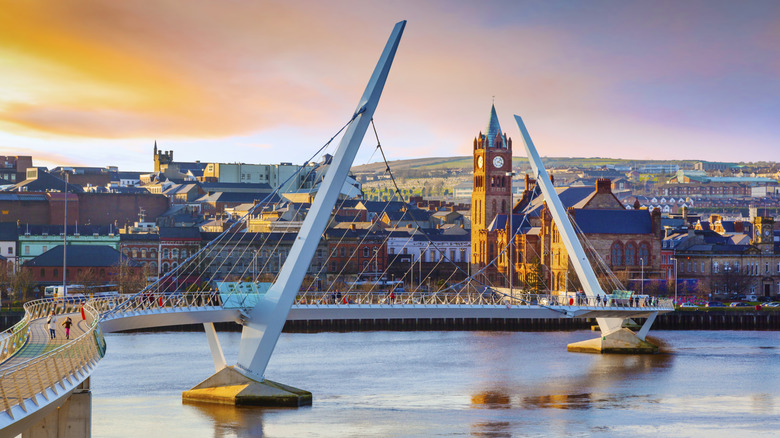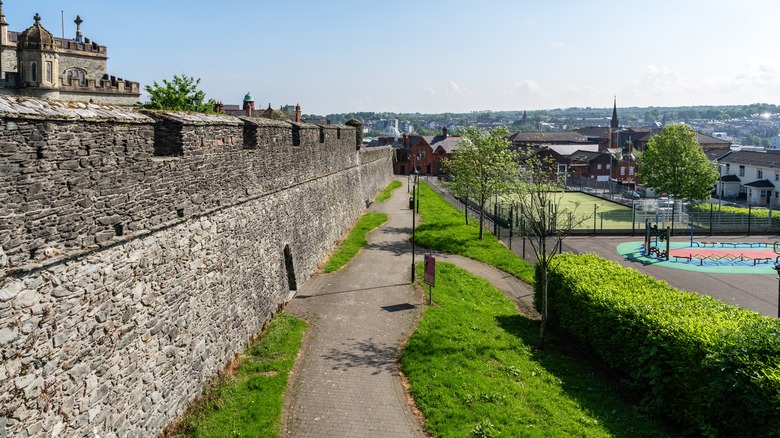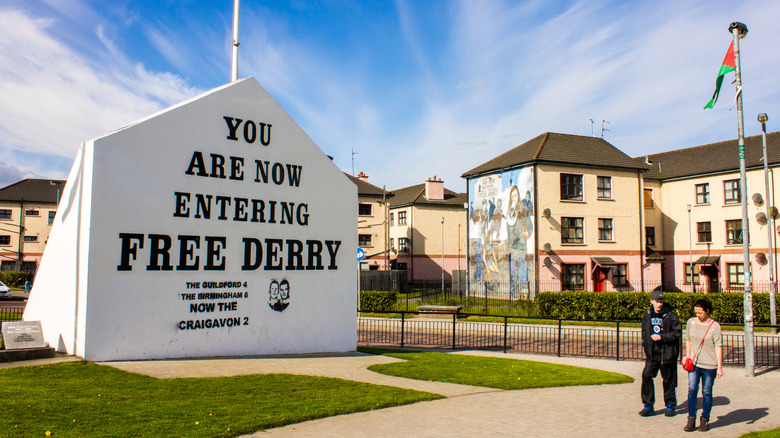Rick Steves Admires The Historic 'Necklace' Around This Underrated Destination In Northern Ireland
Ireland is a land of untamed natural beauty, with rugged cliffs, verdant countryside, fjords, pristine rivers and lakes, heather-covered moors, and forlorn, windswept islands, like this remote rise off the southern coast that is a must-visit for "Star Wars" fans. The Emerald Isle is also home to charming cities, and while Dublin — a great destination for solo travelers — may dominate the conversation, it pays to venture out of the capital to get a real taste of the country's other settlements.
This includes heading up out of the Republic to Northern Ireland, which — despite being politically part of the U.K. — shares deep cultural ties with its sister to the south. While you should not skip the North's capital, Belfast, you should also make time to visit the charming town of Derry, the second-largest city in Ulster (the nine counties that make up Northern Ireland).
Officially labeled Londonderry on maps, Derry — as most locals refer to it — has a fascinating, if tumultuous history. The surprisingly compact city sits on both sides of the River Foyle, and despite the laid-back vibes you'll find today, its past is one of deadly struggle and conflict. This is evidenced by the nearly 20-foot wall that still surrounds the interior of the town, affectionately referred to as the "necklace," a spot that European travel guru Rick Steves says is a "good place to start a Derry visit."
A defensive installation that stands to this day
Derry is the only completely walled city remaining in Ireland, and its stone fortifications were built between 1613 and 1618 to protect Scottish and English settlers who had begun arriving in Northern Ireland. In 1689, the recently-deposed Catholic King James II attacked the city, but its Protestant defenders closed the gates and endured 105 days of siege, emerging victorious in the end.
The Derry Walls held and still stand today as a testament to their sound construction and strength. A stroll around the nearly one-mile perimeter is a way good to soak up the place's rich history — which includes getting an up-close-and-personal look at "Roaring Meg," the legendary cannon that helped repel the relentless attack by James and his army.
According to Steves, a trip to the Walls of Derry also gives visitors a chance to get a glimpse of Bogside, the working-class Catholic neighborhood that played such a major part in the Troubles — the conflict between nationalist Catholics and loyalist Protestants that went on in Northern Ireland from 1968 to 1998. Bogside was a major area of resistance and tragedy, including the Bloody Sunday massacre in 1972, where 13 protestors were shot dead by British troops.
Explore a vibrant city overcoming its painful past
The ghosts of these difficult times linger in the murals that grace the sides of buildings in both the Catholic and Protestant neighborhoods of Derry, but the town today is largely a peaceful place that is safe for travelers. To get a more detailed view of the city's past, stop by the Museum of Free Derry , which offers a deep insight into the struggle for civil rights undertaken by many of the city's residents, though from a decidedly Catholic nationalist point-of-view. Situated in a reconstructed medieval tower, the Tower Museum offers a more balanced look at Derry's history. It also features more modern takes, including an exhibit on "Derry Girls," the popular TV show which helped change outside perceptions of Northern Ireland's second city.
The Free Derry Corner is a monument in the Bogside neighborhood with the words "You Are Now Entering Free Derry" painted onto the side of what was the last structure in a line of rowhouses, a testament to the spirit of resistance that has become synonymous with the town. While there, make sure to also check out the 12 murals — known as the "People's Gallery" — which document the neighborhood's bloody past by paying tribute to those who both fought and gave their lives. This is an emotionally-stirring 200-yard concourse that will stay with you long after leaving.
In 2011, the Derry Peace Bridge was opened and is a must-visit for any visitor. Spanning the River Foyle in a series of curves, this very modern pedestrian structure links both sides of a divided city — Catholic and Protestant — and stands a promise to never again return to those days of sectarian strife. For Northern Ireland's arresting outdoor wonder, check out this underrated natural attraction.


